This is a demo store. No orders will be fulfilled.
Perch Fishing - Build It And They Will Come
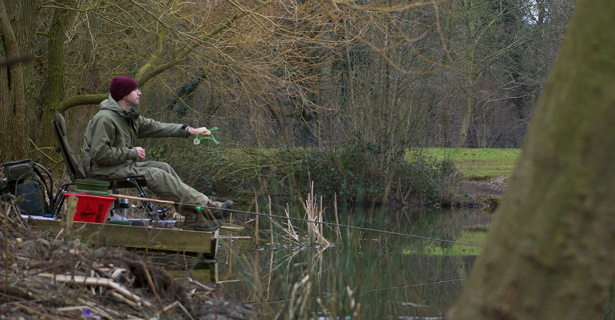

Build It And They Will Come... When it comes to getting big perch out of commercial waters, building your swim match-style is the way to go, as Hardy & Greys angler Gareth Goldson explains.
When you think of a commercial fishery you’ll most likely conjure up an image of matchmen, decked out in colourful outfits, catching pastie-sized carp one a chuck on the pole. However, the dynamics of our nation’s bagging waters are changing. Hidden behind the masses of carp are huge, spiky-finned predators, slowing growing to epic proportions by feasting on the plentiful, protein-packed food that these commercials offer.
More and more clued-up anglers, like top specimen angler Gareth Goldson, are adding commercial waters to their list of big-perch venues, alongside rivers, canals and reservoirs.
Unlike the carp they live with, these bagging-water predators are not an easy target. There are a number of obstacles you’ll have to navigate to catch them. These include avoiding the hungry, headstrong carp for starters – catch one of these and your swim could be ruined for hours. There are ways to aid your mission, though, as we found out when we spent a day with Gareth at Norfolk’s Cobbleacre Lakes.
When targeting commercial perch in the colder months Gareth takes his time to find the right peg. He walks around the lake plumbing the depth, and only when he finds the deepest part will he set up for the day ahead.
“There aren’t usually many features on commercial venues,” Gareth tells us. “So I like to find the deepest part of the lake and fish in open water.”

You may wonder why Gareth picks open-water swims, when perch are known for hiding in among branches and cover, but he has an interesting thought process regarding this. “If you’re fishing a new water you will limit your chances of success if you just target one dark corner of the lake,” he explains. “Okay, there may well be a perch hiding away here but by fishing in a deep, open-water peg and building a swim you’ll be able to draw perch in from all corners of the lake.”
This drawing-in process is key to Gareth’s overall success and to attract the perch he must first attract the lake’s silver fish. “Basically I build my swim for the silvers,” he states. “I really believe that the perch are more attracted to the movement and flashes of these smaller fish – their natural prey food – than the bait that I’m throwing into my swim. Perch are inquisitive by nature and if they see a lot of actively from baitfish, clouding up the water, they will move in to investigate.”
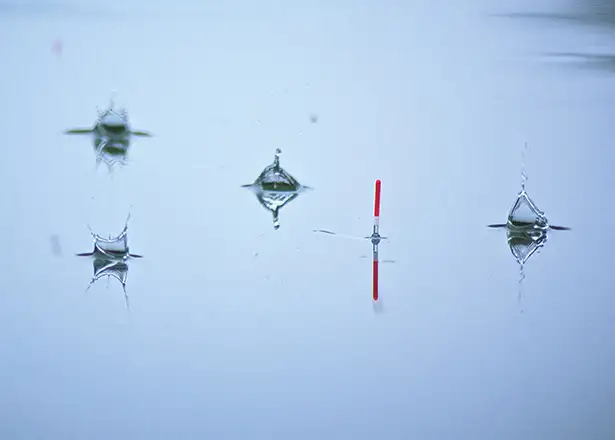
In building his swim Gareth uses different ‘stages’ of feed, effectively creating a pyramid of bait. To firstly draw in the smallest silver fish he creates a sloppy mix using Dynamite Baits The Source Groundbait, liquidised prawns and chopped-up prawns. “I’m convinced that colour is important when targeting perch so my slop mix is a reddy orange. It’s a colour that’s proven to provoke perch into feeding – they really switch on to this colour.”
At the next level Gareth also feeds maggots, as well as the odd piece of chopped-up prawns and worms, these larger items being the next level of the pyramid. He is looking for the maggots to attract better silver fish, which in turn will attract perch. The worms and prawn pieces are there to get his target species interested in his hook baits – lobworms and whole prawns – which will be waiting there for when the perch arrive.

“If I’m honest, livebaits and deadbaits are my top two methods for catching big perch on any water but on commercial fisheries they are often banned. Lobworm and prawn hook baits can be equally effective and these are my two ‘go to’ baits for commercials that don’t allow live and dead baits.
“If you haven’t fished the venue before you’ll need to experiment with both baits to see which works best. I fish on some venues where I can only catch using prawn and others where worm is the top bait, but what I can say is you’ll definitely get a bite on one or the other!” Gareth says with confidence.
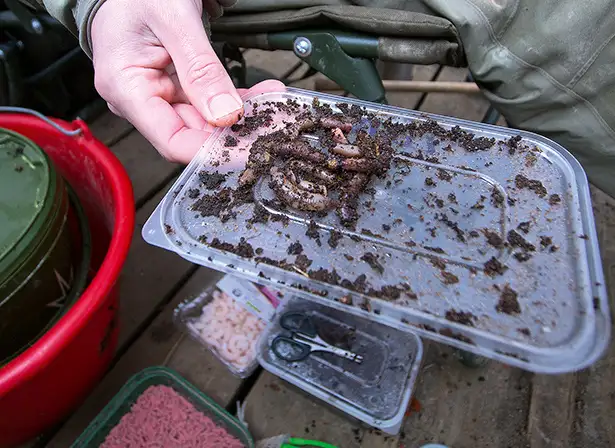
There’s no place for fancy rigs or tackle where Gareth is concerned, he likes to keep things simple and a quick glance at his PB list will tell you that this is certainly the way to go. He puts watercraft at the top of his list when chasing his specimens and, like today, prefers to concentrate on fishing with one rod.
Gareth says that he gets a lot of takes ‘on-the-drop’ so he has no shot down his line; because of this he chooses a loaded waggler and then pinches on a shot either side of the float. This gives him the casting weight needed to reach the deep water, 15 yards in front of him, but once his float hits the water his hook bait will fall down enticingly through the silver fish and this is often the time when it will be snaffled by a hungry perch. There’s no need to shot his float right down, and Gareth likes to have a fair section of the insert showing, because when he gets a bite he likes to give it a second or two before striking. “Your typical perch bite will see a couple of dips and movements of the float before it slides away.”
While plumbing up Gareth detected a sharp drop-off around five yards out, so he decided to also feed a margin area to his left, increasing his chances of a bite. “It’s a cold day today,” he says. “I think I’m going to have to work hard for a bite.” He feeds maggots every minute or so and then offerings of worm and prawn every so often. He adds more of the groundbait slop mix every hour.

There is virtually no wind today and the water is still, clear and cold – not ideal conditions. “I think the perch will have one spell where they feed,” states Gareth. “I can imagine them shoaled up in groups of three or four. These bigger perch are quite solitary creatures and spend their time with only a small number of ‘friends’. I’m looking for one of these groups to find my bait but it’s all about being in the right spot at the right time.”
As the light begins to dim, the birds fly low overhead to roost and the temperature dips, Gareth’s float remains unmoved, apart from the odd twitch which delays the impending packing-up time. Today was not meant to be, but Gareth will be back – he doesn’t give up and he knows that next session could be the one where he’s smiling to the camera with a 3lb commercial stripey.
Get Hooked
1.) Prawn – a favourite of commercial perch anglers across the county. The supermarket-bought prawn, hooked through the back as shown, is a hardy bait that will stay on your hook all day long. It’s also very visual and perch just love them.
2.) Lobworm – the legendary perch hook bait, the humble lobworm has accounted for more specimen perch than any other bait and, when hooked through the saddle, can be fished for long periods of time. The lobworm will wriggle around on the lake bed, enticing perch to feed. Try cutting your lobworms in half if you’re struggling for bites; this will also release the worm’s flavour into the water.
Shop For Perch Fishing Baits
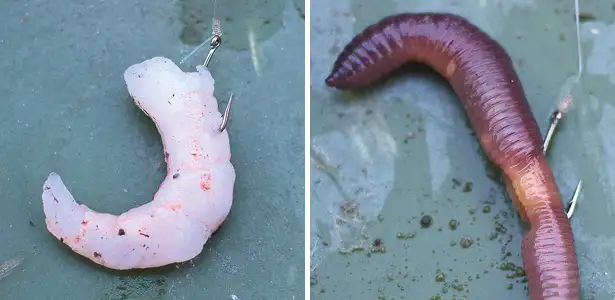
Tackle Up
Rod – 13ft Hardy Marksman Supero A strong yet forgiving rod that can cope with specimen perch and can also handle those rogue carp that you’re likely to encounter in commercials
Line – 4lb Maxima main line Gareth swears by Maxima. He uses it for a lot of his specimen angling and it never lets him down. The 4lb breaking strain he is using today is more than enough to handle any perch swimming in the UK.
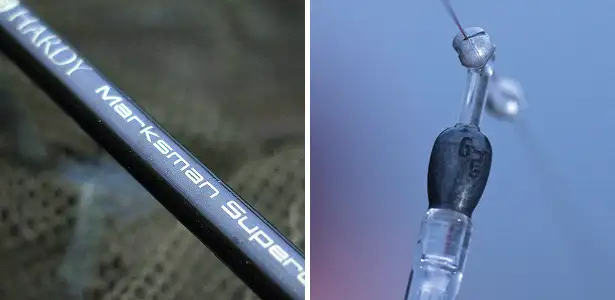
Float – Crystal Insert Waggler In clear water Gareth likes to use crystal floats with the insert giving him added sensitivity. In choppier conditions Gareth would switch to a longer, more stable waggler.
Hook – Drennan Specialist size 10 If he was just using worm Gareth would opt for a size 8 hook, but because he is alternating between lobworm and prawn he prefers a size 10. Like the Maxima line, he trusts his Drennan Specialist hooks. They are strong and reliable, like all of his setup.
Shop For Perch Fishing Tackle
